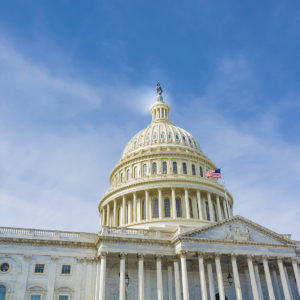Financial markets are sending their loudest recession warning signals since 2007, when the United States was about to enter the Great Recession. And while an “inverted” yield curve is not a guarantee of recession, policymakers in D.C. have already begun preparing their economic stimulus packages. But like every spending plan in D.C. of late, those plans far exceed prior stimulus responses — including by replacing what previously has been temporary stimulus with policies and spending programs that would last forever.
The last major fiscal stimulus package was the American Recovery and Reinvestment Act of 2009. Known informally as the “Obama stimulus,” the legislation funded “shovel-ready” transportation projects, more generous welfare benefits, and a host of other spending and tax relief measures. ARRA cost more than $800 billion, or more than the annual Pentagon budget. And while several subsequent bills extended or supplemented measures included in ARRA, major stimulus policies were indeed “temporary” (which, along with “timely” and “targeted,” economists often cite as the key to effective stimulus).
However, especially in the eyes of the public, ARRA did not keep its promise to create “jobs, jobs, jobs.” As unemployment soared to 10 percent, Americans asked “where are the jobs” and threw House Democrats who supported the plan out of the majority.
Nonetheless, yesterday’s temporary stimulus advocates are doubling down by now proposing to create even larger “automatic stimulus” that would operate permanently in the future.
As laid out in a recent policy guide whose authors include key architects of the 2009 law, automatic stimulus would revive past stimulus policies like federal aid for states, stimulus checks for individuals, expanded food stamps, bigger welfare checks, longer unemployment benefits, added shovel-ready transportation funding. But automatic stimulus would include two key differences.
First, once enacted by Congress, the policies and programs would be permanently authorized, instead of depending on Congress to pass temporary legislation as in the past. For example, added weeks of unemployment benefits would no longer depend on Congress enacting “emergency” legislation. Some new permanent stimulus programs — like “employment subsidies” and jobs for the long-term unemployed already reflected in congressional legislation — would even operate when the economy is not in recession.
The second difference is that these programs and benefits would automatically grow when the economy contracts — again without Congress acting. To be clear, spending on certain government programs expands automatically during recessions under current law. For example, more people already collect means-tested programs as household incomes fall in recessions. Automatic stimulus, however, envisions significant changes to the underlying operating guidelines of programs based on deteriorating economic indicators. So not only would more people qualify for benefits, but the benefits they receive would be greater as well. That means more weeks of unemployment benefits, greater food stamps, and aid for states and more would automatically flow whenever the unemployment rate rises above pre-determined levels.”
In sum, once enacted automatic stimulus would always exist and always grow in recessions, even without Congress taking any further action.
Without knowing the depth of future recessions, it is impossible to know how much all this would cost. But tellingly, to its supporters the advantages of automatic stimulus over the temporary 2009 stimulus law all head in the same direction — toward even greater spending.
According to proponents of automatic stimulus, that temporary 2009 law arrived too late, “discontinued prematurely,” and was “not sufficiently large” in the first place. Proponents also acknowledge the obvious: even if automatic stimulus is enacted, “there will likely still be a need for discretionary policy.” That is, there will always be political demand for temporary stimulus as Congress is under pressure to “do something” whenever recessions strike.
Automatic stimulus supporters also appear to rely on budget loopholes to keep from having to pay for this large permanent rise in entitlement spending, which is already the largest and fastest-growing share of the federal budget. Previous temporary stimulus bills have regularly been designated as “emergency spending,” absolving them from being paid for by equivalent spending cuts or tax hikes.
Automatic stimulus proponents are silent on payfors, suggesting they will make the same “it’s emergency spending” argument, even though it’s hard to call programs that operate outside recessions “emergency” spending. That opens the door to other non-emergency benefits and spending hitching a ride on automatic stimulus legislation, which would grow the price tag even more.
In the end, proponents’ primary case for automatic stimulus rests on the fear that a dysfunctional Congress and administration won’t agree on appropriate temporary responses when future recessions strike. That fear is largely misplaced. In every recession in recent decades, Congress has approved temporary stimulus like extended unemployment benefits and other measures designed to boost spending, hiring, and the economy. With the notable exception of the 2009 stimulus law, past bipartisan cooperation also served as an important brake on the more extreme policy preferences of either party.
Fear of dysfunction, or concerns the 2009 stimulus law didn’t spend enough, are not sufficient reason to abandon that longstanding practice and important policy restraint.

